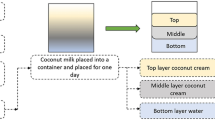Abstract
Fatty acid composition was determined for 105 virgin olive oil samples of the two dominant Cretan olive cultivars, Koroneiki and Mastoides, harvested from different producing areas at different maturity stages. The oils of the Koroneiki cultivar were characterized by lower concentrations of oleic and decaheptanoic and higher concentrations of linoleic and palmitic acids. Oils obtained from high-altitude locations were rich in monounsaturated fatty acids, while oils obtained from low-altitude locations had higher content of saturated fatty acids. Palmitic and palmitoleic acids increased with increasing altitude in both cultivars examined. The statistical analysis of the compositional data showed significant potential for the classification of the samples according to cultivar and location of origin.
Similar content being viewed by others
References
Mincione, B., A.M. Giuffre, U. Leuzzi, and N. Lombardo, Ricerche sugli Oli di Oliva Monovarientali, Nota I, Caratterizzazione della Produzione della Calabria, Riv. Ital. Sostanze Grasse 71:335–338 (1994).
De Leonardis, A., M. De Felice, and V. Macciola, Studio sulla Composizione Acidica degli Oli Vergini di Oliva del Basso Molise, Ibid.:321–325 (1996).
Tsimidou, M., and K.X. Karakostas, Geographical Classification of Greek Virgin Olive Oil by Non Parametric Multivariate Evaluation of Fatty Acid Composition, J. Sci. Food Agric. 62:253–257 (1993).
Frega, N., F. Bocci, and G. Lercker, Composizione Lipidica della Drupa di Olivo di Due Cultivars della Zone del Chianti in Funzione della Maturazione, Nota 1: Trigliceridi ed Acidi Grassi, Riv. Ital. Sostanze Grasse 68:69–74 (1991).
Mariani, C., E. Fedeli, K. Grob, and A. Artho, Indagine sulle Variazioni dei Componenti Minori Liberi ed Esterificati di Oli Ottenuti da Olive in Funzione della Maturazione e dello Stoccaggio, Ibid.:179–187 (1991).
Fiorino, P., and F. Nizzi Grifi, Olive Maturation and Variations in Certain Oil Constituents, Olivae 35:25–33 (1991).
Boschelle, O., A. Rogic, D. Kocjancic, and L.S. Conte, Caratteri Stiche Compositive della Frazione Lipidica di Due Cultivar di Olivo dell’ Isola di Cherso (Croazia) in Funzione della Maturazione, Riv. Ital. Sostanze Grasse 71:341–346 (1994).
Synouri, S., C. Staphylakis, S. Kontou, and V. Tzamzis, Study on the Characteristics of Greek Virgin Olive Oil, Olivae 57:27–33 (1995).
Sanders, T.H., Peanuts Triacylglycerols: Effect of Season and Production Location, J. Am. Oil Chem. Soc. 59:346–351 (1982).
Montedoro, G.F., and L. Garofolo, Caratteristiche Qualitative delli Oli Vergini di Oliva, Influenza di Alcune Variabili: Varieta, Ambiente, Conservazione, Estrazione Condizionamento del Prodotto Finito, Riv. Ital. Sostanze Grasse 61:157–168 (1984).
Ferreiro, L., and R. Aparicio, Influencia de la Altitud en la Composición Quimica de los Aceites de Oliva Virgenes de Andalucia. Ecuaciones Matemáticas de Clasificación, Grasas Aceites 43:149–156 (1992).
Ranalli, G., G. de Mattia, M.L. Ferrante, and L. Giansante, Incidence of Olive Cultivation Area on the Analytical Characteristics of the Oil, Note 1, Riv. Ital. Sostanze Grasse 74:501–508 (1997).
Tsimidou, M., M. Macrae, and I. Wilson, Authentication of Virgin Olive Oils Using Principal Component Analysis of Triglyceride and Fatty Acid Profiles: Part 1—Classification of Greek Olive Oils, Food Chem. 25:227–239 (1987).
Alonso Garcia, M.V., and R. Aparicio, Characterization of European Virgin Olive Oils Using Fatty Acids, Grasas Aceites 44:18–24 (1993).
Stefanoudaki, E., F. Kotsifaki, and A. Koutsaftakis, The Potential of HPLC Triglyceride Profiles for the Classification of Cretan Olive Oils, Food Chem. 60:425–432 (1997).
Cimato, A., Variazioni di Parametri durante la Maturazione delle Olive: Influenza delle Techniche Colturali, Consiglio Nazionale delle Ricerche 3:28 (1988).
Author information
Authors and Affiliations
About this article
Cite this article
Stefanoudaki, E., Kotsifaki, F. & Koutsaftakis, A. Classification of virgin olive oils of the two major cretan cultivars based on their fatty acid composition. J Amer Oil Chem Soc 76, 623–626 (1999). https://doi.org/10.1007/s11746-999-0013-7
Received:
Accepted:
Issue Date:
DOI: https://doi.org/10.1007/s11746-999-0013-7




